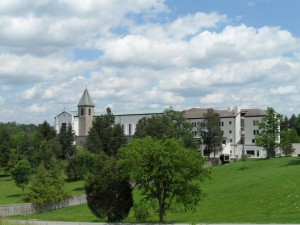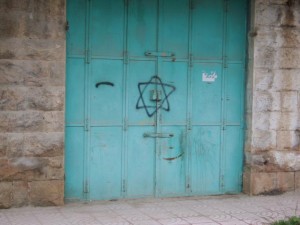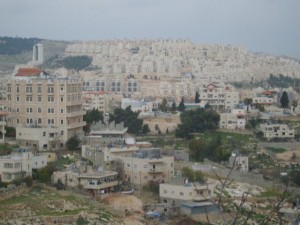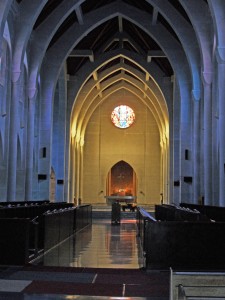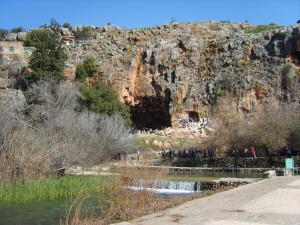In the morning as they passed by, they saw the fig tree withered away to its roots. Then Peter remembered and said to him, “Rabbi, look! The fig tree that you cursed has withered.” Jesus answered them, “Have faith in God. Truly I tell you, if you say to this mountain, ‘Be taken up and thrown into the sea,’ and if you do not doubt in your heart, but believe that what you say will come to pass, it will be done for you. So I tell you, whatever you ask for in prayer, believe that you have received it, and it will be yours. Continue reading
Category Archives: Peace and Justice
Sister Margaret
http://www.nytimes.com/2010/05/27/opinion/27kristof.html?ref=opinion This is a link to an insightful editorial by Kristof in the New York Times on Sister Margaret.
Thomas Merton, who died over forty years ago, is right on target with his assessment of the church today:
It is true that the Lord in the Gospel speaks of His faithful as “sheep,” but that does not entitle us to assume that the liturgy is merely the organized bleating of irrational animals herded together by constraint and trained by an ingenious discipline until they carry out seemingly human actions which they are not capable of understanding. (Seasons of Celebration, 5) The patriarchs would love for us to act like bleating uneducated sheep! Continue reading
We Are One
Lifting up his eyes to heaven, Jesus prayed saying:
“I pray not only for these,
but also for those who will believe in me through their word,
so that they may all be one,
as you, Father, are in me and I in you,
that they also may be in us,
that the world may believe that you sent me.
And I have given them the glory you gave me,
so that they may be one, as we are one,
I in them and you in me,
that they may be brought to perfection as one,
that the world may know that you sent me,
and that you loved them even as you loved me. (Jn 17)
Merton has helped me understand John’s Gospel better, especially the mystical aspects of the Last Supper discourses. Until this Easter season, I did not do much serious lectio on these discourses. They seem to be repetitive and rambling. Now, they are starting to make sense. Continue reading
Nakba, The Disaster
May 15 marked the sixty-second anniversary of the Nakba—the Day of Disaster for the Palestinians. Nakba coincides with Israel’s Independence Day. Both sides are still fighting over land. It is not about religion or racism. The conflict is over real estate.
The present boundaries came to be over time. After Jewish Independence and the Nakba in 1948, Israel fought to gain control over more of the land. Israeli historian, Ilan Pappé, says that 531 Palestinian villages disappeared in the Nakba. Over 750,000 Palestinians became refugees. The war of 1967 allowed Israel to recapture parts of Jerusalem, the West Bank and Gaza. These all became occupied territories. Governments are prohibited by the Geneva Convention and the United Nations Charter and Resolutions from settling on occupied territory. Nonetheless, Israel has refused to withdraw to the 1967 borders and has adopted an aggressive policy of building settlements on the West Bank. The West Bank is becoming a series of isolated ghettos (bantustans). Gaza is already an “open-air prison.” The United States and the United Nations have repeatedly asked Israel to withdraw from these territories. The Palestinians are mainly Muslims but we must remember that there are a significant number of Palestinian Christians. Their numbers are dwindling as the Christians emigrate.
Succumbing to Zionist pressures after the horrors of the Holocaust, the United Nations gave Jews the right to settle in Palestine. The Zionists proclaimed that “it was a land without people for a people without land.” There was one problem with this colonialism. Arabs had populated the land for millennia.
The United States has been supportive of Israel—a democracy in the Middle East. We have contributed on the average of 7 million dollars a day in aid to Israel over the years. Whenever I contact my senators and my congressman about the plight of the Palestinians, they always conclude by reminding me that the Palestinians are terrorists. Security justifies every action.
There is no recognition that over the years Israel has terrorized Palestinians. The cleansing of the land resulted in 33 massacres, including the ferocious massacre at Deir Yassin. Menachem Begin, who later became Prime Minister, gloated over the massacre in his diary (http://www.ifamericansknew.org/history/ref-qumsiyeh.html).
The Israeli occupation continues to terrorize Palestinians today—road blocks, check points, detention, torture, reprisals on noncombatants, Israeli-only highways, and the Wall. An international investigation, which was summarily dismissed by the U. S. Department of State, documented atrocities in Gaza.
By the same token, Israelis have documented repeated acts of terrorism. The American media tends to spotlight the Israeli side of the story. Israel justifies the continued occupation on the grounds of security, especially against suicide bombers. Recently, Roger Cohen, New York Times Columnist, reported, “Netanyahu, in a 20-minute interview, told me of ‘the physical and psychological reality’ of a nation whose experience is that ‘concessions lead to insecurity.’” (http://www.nytimes.com/2010/04/23/opinion/23iht-edcohen.html?ref=opinion) Security remains a concern but many believe Israel overstates its case.
My wife and I participated in a study mission to Israel Palestine two years ago. As I view the situation today, I think back to three encounters we had. The most recent turmoil in Gaza was erupting.
We visited a settler in Efrata who welcomed us warmly into his home. He explained that he had graduated from the University of Wisconsin and what it meant to him to live in Israel. Shortly after we returned to America, I read that a student from Efrata was among those killed at a yeshiva in Jerusalem. I emailed our host and told him I was sorry to hear about the death of the student. I concluded by telling him that I was saddened by the many deaths that were occurring in Gaza. He replied, “Please do not compare the death of the student with the death of terrorists in Gaza.” This is the statement of a man who feels his family’s safety is threatened by Palestinians.
Later in our visit, we had lunch with a Palestinian family in Beit Sahour near Bethlehem. The entire family greeted us. As we ate lunch, the daughter looked at her fiancé and then said to me, “His father was killed by the Israelis.” It was a matter of fact statement and the conversation went on without any further discussion of it. This statement reflects the resignation of a people who are powerless under oppression.
In Ibillin, we met a remarkable man—Archbishop Elias Chacour. He and his family were refugees from 1948. He recounted how they had been forced to abandon their beloved village. They were allowed to return only to witness the village being destroyed by the Israeli air force right before their eyes. Yet, this man spoke with no hate in his heart. He said, “I love the Jews but I hate what they are doing to my people.” Over the years, in spite of Israeli opposition and threats of demolition, Archbishop Chacour has built the Mars Elias educational complex which educates Muslims, Christians, and Jews. The students and their families are learning how to live together. This is the statement of a man who believes people can learn to live together.
Chacour recounts how the Jews and Arabs lived side by side peacefully for many years prior to 1948. As the U. S. presses the Israeli and Palestinian leaders to work toward a solution, there may be signs of hope on the horizon. Maybe they can live peacefully together again.
On April 19, 2010, according to AP reports, Israeli Defense Minister, Ehud Barak, said that “the world will not put up with decades more of Israeli rule over the Palestinian people.” Barak spoke on the eve of Israel’s Memorial Day which is dedicated to fallen soldiers and civilians who have died in terror attacks. The next day is Israel’s 62nd Independence Day celebration. Barak identified three major issues which need to be resolved: the status of contested Jerusalem, determination of final borders, and a solution for the Palestinian refugees. Whether these words will lead to a resolution of the conflict remains to be seen. Barak’s words were more conciliatory than the Prime Minister’s. The same report stated that, in an interview on Good Morning America, Prime Minister Benjamin Netanyahu said he would not stop expansion of settlements in Jerusalem. (http://www.masslive.com/news/index.ssf/2010/04/israeli_defense_minister_ehud.html)
Wrongs have been perpetrated by both parties. If we know the history and facts, then it may be easier for us to follow Chacour’s advice. He asks us to be aware of the plight of the Palestinians but not to become haters of the Jews as a result. We have to offer dignity on both sides if we are to overcome the barriers to peace. Offering dignity, alay dangal, is the Filipino understanding of nonviolence.
As we remember the events and hurts and death and destruction of the past, we need to follow the lead of Elias Chacour. Offering dignity to both sides will lead to common ground. Justice will lead to right order and right relationships between Israelis and Palestinians.
Barak’s comments may signal a new receptivity to a two-state solution on the part of the Israelis. Recent reports of the use of nonviolent resistance strategies on the part of the Palestinians may signal a new willingness to work toward a solution.
In the meantime, let us promote a peaceful solution by being in solidarity with both Jews and Palestinians. Abraham was not a Jew but we—Jews, Christians, and Muslims—are all his spiritual descendants and we can work together for peace in the Middle East. We can urge our government to pursue policies that serve the best interests of Israelis and Palestinians.
Monastery of the Holy Spirit
We recently attended the ground breaking for the new Monastic Heritage Center (MHC) at the Monastery of Our Lady of the Holy Spirit in Conyers, GA. It was a great event and we had the opportunity to visit with some of our monk friends there. Once you enter the long magnolia-lined drive, you know you are on sacred ground, a special place. It is a wonderfully refreshing experience to chant the Psalms with the monks and to Break Bread with them. It is refreshing to walk the grounds in solitude and to be in the presence of the Creator. I even got up at 3:35 AM so I could chant the Nocturnes and meditate in between. What a way to greet a new day!
If you have never visited the monastery, I encourage you to do so. They have a guest house and you experience genuine Benedictine hospitality. If you are already familiar with the monastery, I encourage you to consider a gift to support this effort to help the monks become self-sufficient. We need their continued spiritual presence and this Bonsai Kin-dom (see below) in our midst. If able and interested, please contact Brother Callistus at cal@trappist.net.
The MHC will feature a complex featuring the original barn and will help people understand monasticism and the history of this place. Dom Francis Michael welcomed all. Local officials from the Arabia Mountain Heritage Area Alliance, the City of Conyers, and Rockdale County spoke–there is a deep sense of respect for the monks and the monastery in the local community. The monastery is recognized, as were monasteries of old, as the spiritual center of this community.
Archbishop Wilton Gregory gave a wonderful talk. The monastery specializes in bonsai trees. The archbishop likened the monastery to a bonsai of the Kin-dom of God. It is a miniature of the Kin-dom in our midst. It struck me–all our communities should be Bonsai Kin-doms! Solitude, prayer and solidarity will prune and nurture the Bonsai Kin-dom.
Below are links to the Atlanta Journal and Constitution article and slide show. Enjoy!
Blessings of peace,
Pat
http://www.ajc.com/lifestyle/georgia-monastery-strives-to-526516.html
http://projects.accessatlanta.com/gallery/view/travel/georgia-monastery/
Justice and Peace Kiss
 [The picture of deer kissing speaks of new life, Easter life, spring hope, eternal life now, peace.]
[The picture of deer kissing speaks of new life, Easter life, spring hope, eternal life now, peace.]
Jesus said to his disciples:
“Peace I leave with you; my peace I give to you.
Not as the world gives do I give it to you.
Do not let your hearts be troubled or afraid. (Jn 14:27)
This is part of Jesus’ farewell pep talk to the disciples. Although they do not get it, Jesus wants to reassure them. This is also written for the Johannine community as it tries to grasp the reality of Jesus after the resurrection, after the time he is no longer present to them in the same way he had been. It is written for us as we live in a world where peace is secured by the sword. Continue reading
Community not Collectivity
Everything that the Father gives me will come to me,
and I will not reject anyone who comes to me,
because I came down from heaven not to do my own will
but the will of the one who sent me. (Jn 6:37-38)
Jesus is speaking in the context of the Bread of Life—I AM the Bread of Life. When we examine all the Gospels and all the eating and drinking stories, we understand that he welcomed all to the table. It is called open table fellowship. He partied with tax collectors, prostitutes and sinners. Jesus’ community and the early communities were inclusive. Continue reading
Empty Nets
 The more I study Merton and contemplative living, the less contemplative I seem to be. I know where I want to be but do not seem to be there. Like the Galileans in John 6, I am searching and seeking. The crowd is pursuing Jesus. At one point, they want to install him as king and overthrow Rome. Jesus goes into solitude. Later, after a frantic search back and forth across the lake, they are back again, ““What sign can you do, that we may see and believe in you? What can you do?” Remember this Gospel is the Johannine’s community coming to grips with the reality of Jesus.
The more I study Merton and contemplative living, the less contemplative I seem to be. I know where I want to be but do not seem to be there. Like the Galileans in John 6, I am searching and seeking. The crowd is pursuing Jesus. At one point, they want to install him as king and overthrow Rome. Jesus goes into solitude. Later, after a frantic search back and forth across the lake, they are back again, ““What sign can you do, that we may see and believe in you? What can you do?” Remember this Gospel is the Johannine’s community coming to grips with the reality of Jesus.
The questions of the Galilean crowd show that they are not centered. They do not have a contemplative focus. They are not focused on Jesus as the Bread of Life. They have not fully committed to him. Their hunger and the hunger he came to satisfy are poles apart. Continue reading
Just Another Day?
Yawn—it’s another day.
This is the day God has made.
What will I do today?
Rejoice in God always. Again, I say, “Rejoice!”
Where will I go today?
Go into your room and pray to God in secret.
What will I accomplish today?
Be still and know that I am God.
What will I be today?
Be what you already are in My image.
What will I see today?
I have come to give sight to the blind.
What will I hear today?
Listen to the Word made flesh.
Will I see Jesus today?
Look into the eyes of another person.
What will I eat today?
Do not work for food that perishes.
Will I be OK today?
Look at the lilies of the field.
Will others be OK today?
Feed the hungry, shelter the homeless, care for the sick . . .
Will my fishing net still be empty at the end of the day?
Come to the shore and eat fish and bread.
What a day!
Another amazing gift from the creator!
© J. Patrick Mahon, 2010
Bread of Life
Wes Howard-Brooke’s Becoming Children of God: John’s Gospel and Radical Discipleship, recommended by John Dear, really helps me see the social dimension of John’s Gospel. Chapter 6 which begins today is John’s long chapter on the Eucharist—Jesus is the Bread of Life.
John 6:1-15 is the feeding of the 5000. Jesus, condemning the Judeans, has returned to Galilee—he is back in the boondocks where large crowds follow him and hunger after him. He is home. The locale is the Sea of Tiberias (Galilee). This is where Herod built a great city to replace the city of Sepphoris. It was built on “a necropolis—a city of the dead—which made it unclean under the Torah. Thus the Jesus’ followers from this city were unclean. They were seeking relief from the tyranny of the “Judean Temple-state.” Howard-Brook goes on to say, that the crowd “in their pursuit of basic economic security . . . had chosen to let go of the religious security of Torah obedience. In the world of the Johannine community, these people were not a historical relic like the Jerusalem priests, but a thriving mass of humanity in search of satisfaction of their hunger.” People in many communities in the United States and around the world can readily identify with the hungry crowd. Continue reading

